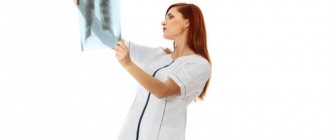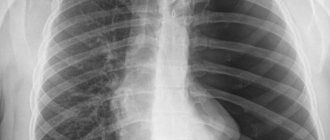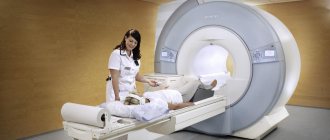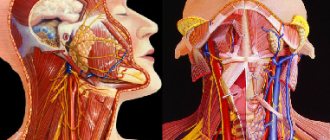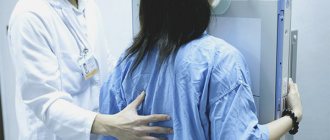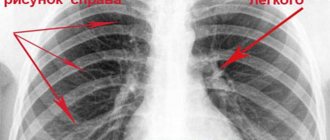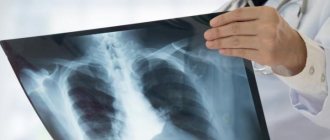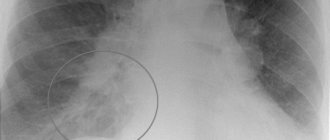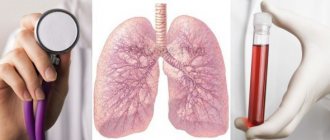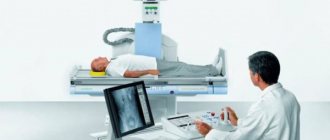Fluorographic examination refers to x-ray diagnostic methods. The essence of the method lies in the ability of body tissues to unevenly absorb ionizing radiation that passes through the human body during the procedure.
The result is a reduced-scale image of the area being examined, which helps to exclude or detect disease. Fluorography refers to screening methods of examination, i.e. it is widespread and is used to detect pathology of the bronchopulmonary system in the early stages, when symptoms of the disease have not yet arisen.
Most of the population undergoes such examination, therefore, there are a huge number of questions related to diagnosis. One of the most common is “Can I eat before fluorography?” To answer this, you need to find out which organs are visible in the image.
Can I eat before the examination?
There is no need for special preparation for fluorography. But it is worth considering that the position of the diaphragm affects the result, so you should not eat too much immediately before fluorography. If a person has a full stomach, then the diaphragm moves upward greatly, which leads to the fact that the picture is incorrect.
You can eat in the morning, but in moderation. The optimal breakfast is oatmeal or a boiled egg, tea and a piece of bread with butter. You should not eat food that is difficult to digest. In this case, you will feel heaviness in your stomach all day.
If you are prone to constipation, then on the eve of FLG you should take a mild laxative to cleanse your intestines.
Contraindications for the study
If you familiarize yourself with how fluorography occurs, what this type of research is and what it is based on, it will become clear that this procedure is not so harmless. Therefore, there are a number of restrictions on its passage.
Age up to 15 years
It will not be possible to find out what fluorography is or how such a procedure is done if the patient is under 15 years of age. This is due to the fact that the effect of X-ray radiation on a child’s body is much stronger than on an adult. In this regard, a doctor can prescribe fluorography only as a last resort, when there is a threat to life.
Severe respiratory failure
Respiratory failure is a serious contraindication to fluorography. The thing is that radiation can have a negative effect on the human body and worsen an already bad condition. It is best to opt for a more gentle diagnostic method, for example MRI. Fluorography is safer than x-rays, but it is still extremely undesirable in such a situation.
Pregnancy
If you are thinking about how to undergo a fluorography procedure if you are pregnant, there is only one answer - nothing. Pregnancy is an absolute contraindication, since X-rays can affect the body of both the expectant mother and the baby. The child is at much greater risk; the harm can be so significant that it can lead to the loss of the fetus.
We can talk about how to prepare for a fluorography procedure during pregnancy only when there is a threat to life.
In this case, the doctor can determine whether there are other research methods, and, if there is no other way out, try to reschedule fluorography to the third trimester. In later stages, x-ray examination is less dangerous, since all the vital systems of the child have already been formed. #!RentgenVRA4!#
Is it possible to smoke before FLG?
Many people have a natural question: is it possible to smoke before fluorography? It’s worth saying right away that the cigarette you smoke does not in any way affect the results of the study, whether you have respiratory diseases or whether they exist or not.
Smokers are more susceptible to respiratory diseases, so they definitely need to undergo FLG once a year . This examination allows you to identify pathologies at the earliest stages.
If a person is very worried that smoking will distort the examination result, it is worth giving up smoking, at least for a few hours.
Is it possible to eat before fluorography? Preparation for the procedure
Every year, citizens of the Russian Federation are recommended to conduct a fluorographic examination. This procedure is carried out for preventive purposes.
In addition, it can be used to diagnose respiratory pathologies at an early stage. It is known that there are a number of rules and restrictions that a person must adhere to before certain medical procedures.
This article talks about whether it is possible to eat before fluorography.
Features of the procedure
This event is carried out as part of a comprehensive examination, routine medical examinations and medical examinations. Regardless of the purpose, any medical procedure requires preparation.
In this regard, many patients are interested in the question of whether it is possible to eat before fluorography.
To understand whether this limitation exists, you need to find out how the device with which the procedure is performed works.
The medical procedure is carried out to diagnose pathologies of the chest organs (breasts, lungs, heart).
Sometimes it is performed to assess the condition of bone tissue. X-rays that pass through the body create an image of it. The picture is transferred to a special surface - the screen. The photographs are reflected on film or digitized. This research method is quite cheap and simple, which explains its popularity.
In the images obtained with the help of the device, you can see the lungs, collarbones, heart, bronchi, chest, shoulder blades, vertebrae and other structures of the upper body.
What is the purpose of the procedure?
If we are not talking about a routine medical examination or medical examination, the examination is carried out to detect oncological pathologies or pulmonary tuberculosis in the early stages. In addition, this event allows you to identify other conditions, for example:
- Inflammatory process.
- Bronchitis.
- Presence of foreign bodies.
- Hernias.
- Cysts, ulcerations.
- Tumors.
- Fibrosis.
The organs of the digestive system are not involved in this diagnostic procedure. In addition, the stomach is separated from the chest area by a diaphragm, so it is not subject to scanning. Therefore, the answer to the question of whether it is possible to eat before fluorography will be in the affirmative.
There are research methods that involve the injection of contrast fluid to obtain a clearer image. In this case, the patient must remember certain restrictions.
He should not eat or drink eight hours before the medical event. However, in the diagnostic process discussed in the article, no contrast agent is used. Therefore, there are no such restrictions.
This is another reason why the answer to the question: “Is it possible to eat before fluorography?” is affirmative.
Is the procedure done on an empty stomach?
Some patients are interested in whether it is permissible to carry out this activity on an empty stomach. There is no need to worry about this. The state of the digestive organs does not affect the examination result in any way. This is explained by the fact that they are separated from the respiratory system by a diaphragm.
It is no coincidence that patients ask the question of whether it is possible to eat before fluorography. After all, the result of some types of research (for example, ultrasound diagnostics) is distorted if on the eve of the event a person ate foods that cause the formation of gases. This means that there are certain restrictions and ways to prepare for the procedure. However, they do not concern this manipulation.
People who are about to undergo such an event are interested not only in the question of whether they can eat before fluorography.
Patients are also concerned about whether the medications they take will affect the results of the procedure. Medicines do not affect the diagnosis in any way, and therefore they are allowed to be taken.
Smoking and alcoholic drinks
Cigarettes smoked one hour or even thirty minutes before the procedure do not affect its results.
Many people remember how teenagers at school were frightened with the idea that the event would reveal the presence of a bad habit. This statement is false. The device is not able to determine whether the patient smokes or not.
It diagnoses only pathologies that occur due to a bad habit (for example, malignant tumors in the lungs).
Is it possible to drink alcohol before fluorography?
Alcohol-containing products cannot change the examination result. However, we must not forget about social factors: clinic staff and other patients will be unpleasant that a drunk person is next to them.
Fluorography is a fairly simple and popular diagnostic method. It is used in many situations. The event does not require special preparation. The answer to the question of whether it is possible to eat before fluorography of the lungs is affirmative. Smoking is also not prohibited.
However, taking into account social factors, on the day of this examination you should not consume alcohol-containing products or eat dishes with a lot of garlic or onions. Compliance with these rules will show respect for the staff of the medical institution and will not cause negative emotions to the people around you.
Source: https://FB.ru/article/466568/mojno-li-est-pered-flyuorografiey-podgotovka-k-protsedure
Can I take medications?
People who suffer from chronic diseases constantly take medications. It is impossible to refuse medications in the following cases:
- For diabetes.
- For diseases of the cardiovascular system.
- For hypertension.
- For diseases of the blood circulation and brain.
In addition, there are a number of other diseases for which taking medications on schedule is mandatory.
If a person with a chronic disease should undergo fluorography. You should not refuse to take medications prescribed by your doctor. You need to know that only X-ray examinations performed with the use of a contrast agent require the discontinuation of certain medications. FLG does not apply to this type of examination.
Why is fluorography of the lungs so popular?
For the patient, fluorography of the lungs is a simple method of examination that does not require absolutely any special preparation. There is no need to deny yourself anything, exclude any foods from your diet or stop taking any medications.
Photo 2. A man undergoing fluorography does not prepare for it in advance. A nurse is watching him.
In this sense, FLG is suitable for everyone. The only exceptions are children and early pregnant women , as well as persons temporarily unable to undergo the procedure due to the inability to maintain an upright body position.
Reference! Restrictions apply only to the presence of foreign objects in the field of study (projection of lung tissue onto the surface of the chest) due to the fact that they can make the image inaccurate.
The popularity of the fluorographic method is explained by its relative cheapness, speed (with proper organization of the process) and, as a result, significant throughput, which allows the use of FLG as a screening for pulmonary tuberculosis.
Is it possible to play sports
Some people mistakenly believe that before conducting a fluorographic examination they should not play sports and it is better to refrain from active physical activity. Indeed, physical exercise activates the respiratory system and improves blood circulation. But it is worth remembering that sport cannot affect the tissues of the respiratory organs themselves.
You can exercise both the day before and immediately before the procedure. It is only desirable that your breathing becomes even before the examination.
When should a chest x-ray be taken?
Plain radiography of the chest organs is carried out:
- During an annual preventive health examination to identify risk factors and life-threatening diseases such as cancer or tuberculosis.
- For pain in the chest and heart area.
- With painful or bubbling breathing, sensations of lack of air.
- With loss of appetite and a sharp decrease in body weight.
- For swelling and high blood pressure.
- For injuries, to identify foreign objects in the esophagus, lungs, and respiratory tract.
- If you suspect lung diseases: pneumonia, abscess, pleurisy, silicosis, etc.
General recommendations
You can undergo fluorography at any time of the day. Some people who constantly work and cannot leave work again are examined in private medical centers. In such medical institutions, you can undergo an FLG examination almost around the clock, but you must first make an appointment by phone for a convenient time.
No special preparation is required for this procedure, but the following requirements must be taken into account:
- Before the examination, all metal jewelry must be removed from the chest.
- Women should pin up their long hair.
- The bra is removed.
It is important to listen to your healthcare provider. At his command, you need to take a deep breath and hold your breath for a few seconds.
The FLG image is usually ready the next day, but in private medical centers it can be picked up within half an hour.
What documents determine the obligation to undergo a fluorographic examination?
The obligation of students and workers to undergo fluorographic examination is due to the need to ensure sanitary and epidemiological well-being, including on the territory of St. Petersburg Electrotechnical University "LETI", and is regulated by the following regulatory documents:
- Law of the Russian Federation dated November 21, 2011 No. 323-FZ (as amended on May 29, 2019) “On the fundamentals of protecting the health of citizens in the Russian Federation”,
- Federal Law No. 52-FZ of March 30, 1999 (as amended on July 26, 2019) “On the sanitary and epidemiological welfare of the population,”
- Federal Law No. 77-FZ dated June 18, 2001 (as amended on August 3, 2018) “On preventing the spread of tuberculosis in the Russian Federation”,
- By order of the Ministry of Health of the Russian Federation dated March 21, 2017. No. 124n “On approval of the procedure and timing of preventive medical examinations of citizens in order to detect tuberculosis”,
- Appendix No. 12 to the order of the Ministry of Health of the Russian Federation No. 109 dated March 21, 2003 (as amended on June 5, 2017) “On improving anti-tuberculosis measures in the Russian Federation”,
- Resolution of the Chief State Sanitary Doctor of the Russian Federation dated October 22, 2013 No. 60 (as amended on 02/06/15) “On approval of sanitary and epidemiological rules SP 3.1.2.3114-13” “Prevention of tuberculosis”,
- By order of the Ministry of Health and Social Development of the Russian Federation dated April 12, 2011. No. 302n “On approval of lists of harmful and (or) dangerous production factors and work, during the performance of which mandatory preliminary and periodic medical examinations (examinations) are carried out, and the procedure for conducting mandatory preliminary and periodic medical examinations (examinations) of workers engaged in heavy work and at work with harmful and (or) dangerous working conditions” (clause 18 of Appendix 2).
- Order No. OD/0220 dated April 26, 2019 “On the organization of fluorographic examination of students and workers at St. Petersburg Electrotechnical University “LETI””
Is fluorography harmful?
There is a common misconception that fluorographic examination is harmful to health. In fact, the radiation dose received during FLG is negligible and does not affect health in any way. For preventive purposes, you can undergo such an examination once a year, but in some cases it is recommended to undergo fluorography 2 times a year, even in this case the radiation dose does not exceed the maximum permissible.
To reduce the harmful effects of x-rays on the body, it is recommended to undergo examination using modern digital devices . In such cases, the radiation dose is reduced several times compared to X-ray machines of older modifications.
When undergoing an X-ray examination and fluorography, the patient’s medical record records what dose of radiation he will receive. This helps prevent exceeding the maximum dose per year.
There are common misconceptions among people that you should not smoke, exercise or take medications before fluorography. All these misconceptions are wrong; you can even eat before the examination, but in moderation.
How to prepare for fluorography
Fluorography is a popular and at the same time simple method for diagnosing lung pathology, which is one of the variations of x-ray examination. Preparation for fluorography is minimal; it is important not to distort the result by following the simplest recommendations.
Digital scanning fluorograph (the safest and most modern diagnostic method)
The only thing that can affect the examination results is the presence of foreign objects in the area of the fluorograph sensor. Therefore, before fluorography, pay attention to the following nuances:
- Remove jewelry around your neck - no matter what material it is made of, it needs to be removed. For this reason, during the examination you may be asked to put a chain with a cross or pendant in your mouth.
- Remove your bra—even if the piece of underwear doesn't have underwire or embellishment.
- Hair - in order not to distort the picture of the study, it is also recommended to pin up long hair in a bun if it falls onto the chest.
X-ray of healthy lungs
Important! It is necessary to undergo an examination using a digital or digital X-ray scanning machine, the radiation dose will be 0.02-0.05 mSV. In the film version of the device - 0.1-0.3 mSV, which is extremely harmful. For comparison, the natural background of Moscow is 0.02 mSV. Find out information about the equipment from the x-ray technician.
Foreign objects in the area where the lungs are examined by a fluorograph create extraneous fragments or shadows in the image. This not only leads to the fact that the specialist may miss the pathology, but also may cause an erroneous diagnosis.
Decoding the image in the photo
Tuberculosis
The principle of diagnosis through fluorography involves the passage of X-rays through the chest tissue. The latter's penetration of dense tissue is recorded on the CCD matrix; darkening indicates pathology.
The radiologist interprets the X-ray photograph. In this case, the nature of darkening in the lung tissue is taken into account; the following indicators can be distinguished:
- Segmental spots are darkening in the shape of a triangle, framed by a light outline. A single manifestation indicates injury to the lung tissue, the presence of a foreign object or endobronchial tumor in the organ area. If there are 2 or more triangles, this may be pneumonia, oncology, fluid in the pleural area, tuberculosis or the spread of metastases.
- A lobar spot outlined with a clear outline is a pulmonary disease, for example, purulent inflammation, bronchiectasis, and others.
- Focal darkening or a spot up to 10 millimeters in size indicates pathologies of the heart and blood vessels, an oncological neoplasm. The focal spot is characteristic of myocardial infarction, but an MRI is required to clarify the diagnosis.
- Focused spots on the surface of the organ indicate different types of pneumonia, the development of bronchial asthma, purulent inflammation in the lungs, helminthic infestations or accumulation of pleural effusion.
Interpretation occurs in different ways, so interpretation should be done by an experienced radiologist. It is important to know that healthy lungs in photographs have a uniform color, and the heart and bronchi look light.
The main argument in favor of the undesirability of fluorography for a child under 15 years of age is the anatomical and physiological characteristics of the child’s body. The device for performing FLG, by projecting an image of the lungs onto film, reduces it. Therefore, an image of a child’s lungs will be more difficult to read than that of an adult, which reduces the information content and relevance of the diagnosis.
If there are no serious reasons for performing fluorography, doctors do not recommend performing it on children for a number of reasons:
- Increased susceptibility to ionizing radiation, which threatens somatic disorders.
- Due to the increased sensitivity of the tissues of a young body to radiation, the risk of developing cancer increases.
Limitations of the study
People who are preparing for a chest x-ray through fluorography, but have not had this procedure in a long time, often wonder what they can and cannot do the day before. Many people mistakenly believe that it is impossible to:
- eat before the test;
- expose yourself to physical activity;
- smoke;
- drinking alcohol;
- take medications.
Cancer
Some of these restrictions relate to the collection of blood, urine and other biomaterial, but do not apply to the examination of the lungs; there is no special preparation for fluorography.
Only lung diseases or exposure to long-term adverse factors have a negative effect on lung tissue. A cigarette smoked before diagnosis will not change the results in any way if a person has been smoking for 10 years and vice versa.
The only preparation is hygiene measures; before FLG it is enough to take a shower.
Fluorography is recommended for persons over 18 years of age to undergo fluorography at least once a year. This is required to reduce the likelihood of morbidity among the population and maintain records of patients. This examination method is suitable for almost every person, with only 2 exceptions:
- persons under 15 years of age;
- pregnant women, especially in the first trimester.
The mentioned contraindications are explained by the adverse effects of X-ray radiation on a young body (child or fetus). However, there are exceptions here, because if a lung disease is suspected, the doctor can prescribe a referral even for a woman during pregnancy and breastfeeding.
Fluorography is a common, safe and informative method of monitoring and identifying lung disease. Conducting the study does not require serious preparation. But despite the safety, it is worth remembering the contraindications and not violating them unless absolutely necessary or recommended by a doctor.
https://youtu.be/3AUznb9wlxc
Source: https://osnimke.ru/interesnoe-o-rentgene/flyuorografiya-podgotovka.html
What device do you use for radiographic examination?
The Clinic on Komarova uses the latest generation universal X-ray complex - AGFA DX-D 300 (2016), the only one in the Far East. Modern digital technologies make it possible to obtain images of the highest quality with minimal radiation exposure, which have undeniable diagnostic effectiveness.
For comparison, when performing digital chest radiography AGFA DX-D 300, the radiation exposure is only 0.03 mSv (millisievert) per procedure, which is 17 times lower than with conventional fluorography (0.5 mSv), 10 times lower than with conventional radiography (0.3 mSv) and 2 times lower than with digital fluorography of the chest organs (0.05 mSv).
One of the unique features of the AGFA DX-D 300 is an individual approach to research. The German company has thought through everything to improve the level of patient comfort. The maximum flexibility and motorization of the AGFA DX-D 300 allow the equipment to independently take a position in space relative to the patient during the examination. This unique feature makes it easy to carry out a wide variety of examinations on any population, be it children, the elderly or patients with limited mobility.
Age
Can minors get piercings? Yes, if you are over 15 years old. At an earlier age, a problem with decreased immunity may arise.
The only acceptable procedure is ear piercing. But it can only be done on soft tissues, without affecting the cartilage.
Ear piercing affects cartilage, so it can only be done by adults
What will the photo show?
Modern equipment uses a computer model, converting the resulting image into a multimedia format.
The image shows the condition of bone tissue and the cardiovascular system
Thanks to X-rays, doctors can see the condition:
- Bone tissue. The images clearly show the collarbones and shoulder blades, ribs and thoracic spine.
- Of cardio-vascular system. The doctor will be able to see not only the “motor”, but also the main blood channels that branch from it.
- Respiratory apparatus. In addition to both lobes of the lung with all the bronchi, the specialist will also see the pleural cavity and the diaphragm.
The digestive system is not included in this list. There are 2 main reasons for this:
- The esophagus, which connects the throat to the stomach, is hidden behind the mediastinum. This is the space between the lobes of the lungs. In front it is protected by the sternum, and on the inside it is lined with adipose tissue. Thanks to this, the esophagus hides behind the shadows of other organs in the picture.
- The stomach is located outside the area that is recorded during fluorography. This organ is located below the diaphragm.
Therefore, the question of whether it is possible to eat before fluorography is considered meaningless. No one has ever prohibited this, but you definitely shouldn’t starve before the examination. Just avoid eating a lot of onions or garlic out of respect for your healthcare provider.
